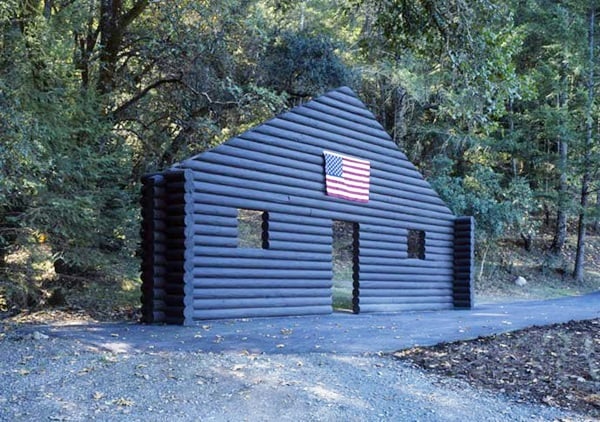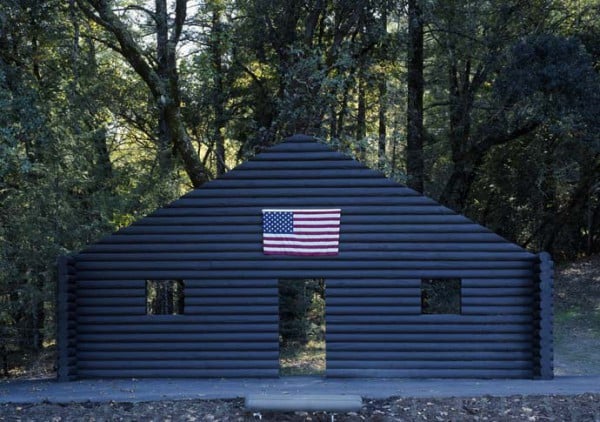Galleries
Cady Noland Disowns $1.4 Million ‘Log Cabin’ Artwork Sparking Collector Lawsuit
No way to calm "crazy" Cady down, dealer says.

No way to calm "crazy" Cady down, dealer says.

Eileen Kinsella

Cady Noland has developed quite the reputation as a control freak over the ownership and presentation of her artwork.
A work she recently disowned once she discovered it was altered is now at the center of a Federal Court case.
The work in question, titled, Log Cabin Blank With Screw Eyes and Cafe Door (1990), consists of a wooden facade with a US flag placed above the entrance. It is consistent with the themes the artist has become best known for, including exploring the darker side of the American Dream, but it is reportedly the only one of Noland’s works that she made with the intention that it be displayed outdoors.
Log Cabin, which came to be known as a memorial to San Francisco Museum of Modern Art chief curator John Caldwell, who passed away in 1993 at the age of 51, was in Berlin for the past decade. During its time there, some of the wood began to rot.

Cady Noland’s Log Cabin Blank with Screw Eyes and Cafe Door.
Image: via Stonescape.us.
Scott Mueller, a collector who is a trustee at Cleveland’s Museum of Contemporary Art, eventually became interested in the piece and agreed to buy it in July 2014, in a deal brokered by Galerie Michael Janssen. The suit says Mueller agreed to pay $1.4 million as the total purchase price for the work; after Noland’s disavowal of the installation, Mueller alleges that the Janssen Gallery hasn’t repaid his original transfer, which was $800,000.
Noland, who is one of the most expensive living female artists, apparently became furious when she learned that the work had undergone restoration, according to a post in Courthouse News.
The artist sent Mueller a handwritten note stating, “This is not an artwork,” and objecting to the fact that the sculpture was “repaired by a consevator [sic] BUT THE ARTIST WASN’T CONSULTED.”
But it sounds like those involved in the deal were well aware Noland might react this way. According to the purchase agreement, which artnet News obtained a copy of yesterday, the deal included a detailed buy-back option, acknowledging that “the original logs of the work’s facade were refabricated and/or that any original material of the Work may have been discarded or destroyed without the Artist’s knowledge and/or approval.”
According to the agreement: “During the approximately ten years the artwork was exhibited outside [in Germany] the artwork suffered significant damage and deterioration due to its material composition, the inherent nature of its wood and other physical components, and the effects of weather, seasonal changes in climate, time, and other natural elements.”
Further, the clause anticipated that the artist could potentially take any of the following measures: “Affirmatively refuses to acknowledge or approve the legitimacy of the work; seeks to disassociate her name from the Work; or claims that her moral rights, rights under the Visual Artists Rights Act or other similar legislation have been violated.” In these events, the person who first learned of this objection should “promptly inform the other.”
The agreement says following a condition report that was prepared in 2010, it was recommended that the “only way to ensure the long-term viability/existence of the artwork would be to replace the rotting logs with new ones…The original logs were replaced and a new log cabin facade was reconstructed,” by the original fabricator to her original specifications.
According to Mueller’s complaint, “Noland angrily denounced the restoration of the artwork without her knowledge and approval. She further stated that any effort to display or sell the sculpture must include notice that the piece was remade without the artist’s consent, that it now consists of unoriginal materials, and that she does not approve of the work.”
In his suit, Mueller also named German collector Wilhelm Schurmann, who owned the work, and Manhattan-based Marisa Newman Projects, who acted as an independent art advisor.
The suit contains this gem: Gallery owner Michael Janssens told one of Mueller’s reps that there were “not much options to calm ‘crazy’ Cady down.”
The purchase agreement contains what appears to be an airtight buyback and indemnification clause: Janssens “hereby agrees to indemnify and hold harmless the Purchaser…from and against losses incurred…as a result of any and all claims and liabilities…”
This past fall, after attending a group show at the Brant Foundation Art and Study Center in Greenwich, Connecticut, artnet News overheard photographers being informed that Noland’s artwork was not to be visible, even in the background, because the artist refused to endorse the show.
Since Brant owns the works, there was not much Noland could do legally; nevertheless, the show featured a plaque that read:
“Because Ms. Noland have [has] not been involved with the chain of provenance with many of my [her] pieces there are more situations like this show which place demands on her time and the artist’s attention to ensure proper presentation of her artwork (including its representation in photographs), than she has time or capacity to be involved with. She reserves her attention for projects of her own choosing and declined to be involved in this exhibition. The artist, or C.N., hasn’t given her approval or blessing to this show.”
That wasn’t the first time Noland was at odds with those interested in her and her artwork, of course. In 2012, she was famously sued by Swiss art dealer Marc Jancou for disowning Cowboys Milking, an artwork he consigned to Sotheby’s, thereby forcing the auction house to remove it from their sale. She also turned down a curator at the Museum of Modern Art when the museum expressed interest in mounting a retrospective of her work.
In her book 33 Artists in 3 Acts, art writer Sarah Thornton described Noland’s erratic and paranoid behavior upon meeting with her in person.
“Noland laments the way auction houses ‘throw artworks together pell-mell…it’s terrible when the element of chance is introduced’ she explains. ‘An auction is like throwing up the dice. It’s like cutting up a writer’s words and throwing them up in the air. If I had known everything would be flipping at auction, I would have made works that were impervious. I know it sounds crazy, but…’ she stops talking when a woman in dark glasses sits down at a neighboring table. Noland’s vibe is so intense that the woman gets up and moves further away.”
Thornton continues that Noland “finds it distressing when her sculptures are incorrectly installed and combined with works that engender the wrong kind of dialogue.”
According to Thornton’s book, Noland has become so obsessed with her old work that she’s been unable to create anything new in years. She admitted to Thornton that “I’d like to get into a studio and start making work,” but that tracking the old work has become a “full-time thing.”